Why Quantum Computing: Products
So far so good, the quantum world 1) is full of discrete things that readily fit into our current paradigm of computing, and 2) it plays with those discrete things in a probabilistic but wave-y kind of way. The last piece of the puzzle is subtle but deeply important and powerful, it is the way quantum things scale.
It is fundamental to the quantum world that more is different. In a universe with more than one quantum mechanical thing, the whole is greater than the sum of its parts. Take two quantum particles (electrons, photons, quantum lottery tickets…); individually they each behave like wave-y particles, and together that’s still true but it’s also true that the pair of them together acts like its own distinct wave. Mathematically, systems that combine this way do so through the tensor product. But let’s not get ahead of ourselves.
More is Different
Just look at it all, take it all in… Nature is complicated. So much going on on so many scales. In principle it all boils down to a few simple laws, but in practice those laws become exponentially harder to follow the more things are following them. More is different.
With enough complexity, the only practical way to go is to start from scratch—that’s why we have all these different sciences, like chemistry and biology. But there’s a place between the simple and the intractable, a place where we can use simple things to interpret, but not completely understand complicated things. In physics, this is usually the place where the “tensor product” shows up.
Instead of deriving it mathematically, let’s just jump right into an example you know intuitively: mechanical stress1.
Is the Tensor in the Room With Us Right Now?
Happens all the time; you got caught up re-watching your favourite ’80s giant robot anime and now you’re late for your totally-legit2 crypto seminar so you get stuck with the 30-year-old plastic folding chair in the corner. You sit down and now have to spend the whole life-changing$^\text{tm}$ hour hoping your elderly chair has one more fight in it, that it can withstand the stress of your posterior for just long enough for you to find out how to earn them $$$ and quit your dead-end office job.
The chair doesn’t look different, but you know it’s different when you’re sitting on it. You know there’s a delicate balance of forces pushing and pulling different parts of the chair on the inside, but you might have a harder time pointing out exactly what forces and where.
Mechanical Stress is its own thing. It’s an emergent property of big things (the plastic chair) that are made up of bazillions of small things (plastic polymers, themselves atoms). An atom can’t feel stress3, but enough atoms pushing and pulling each other add up to a belt feeling stress over the diet of its wearer. We can break the concept of stress down to a pairing (mathematically a product) of forces with geometry, but any specific example of stress is not necessarily just one force bending one shape. Mathematically this pairing is a tensor product ($\otimes$):
\[\text{Stress} = \text{Geometry}\otimes\text{Force}\]Let’s look at this more systematically in a controlled environment.
Domesticated Entanglement
It turns out that some transparent materials actually change how they interact with light when under stress. This is a phenomenon called photoelasticity; in particular, sometimes the stress can change the refractive properties of different polarizations of light, so if you stick the thing between a pair4 of sunglasses like my setup from part 2 you see pretty patterns that show you where and how much stress exists in the object. Here are some examples I found around the house:
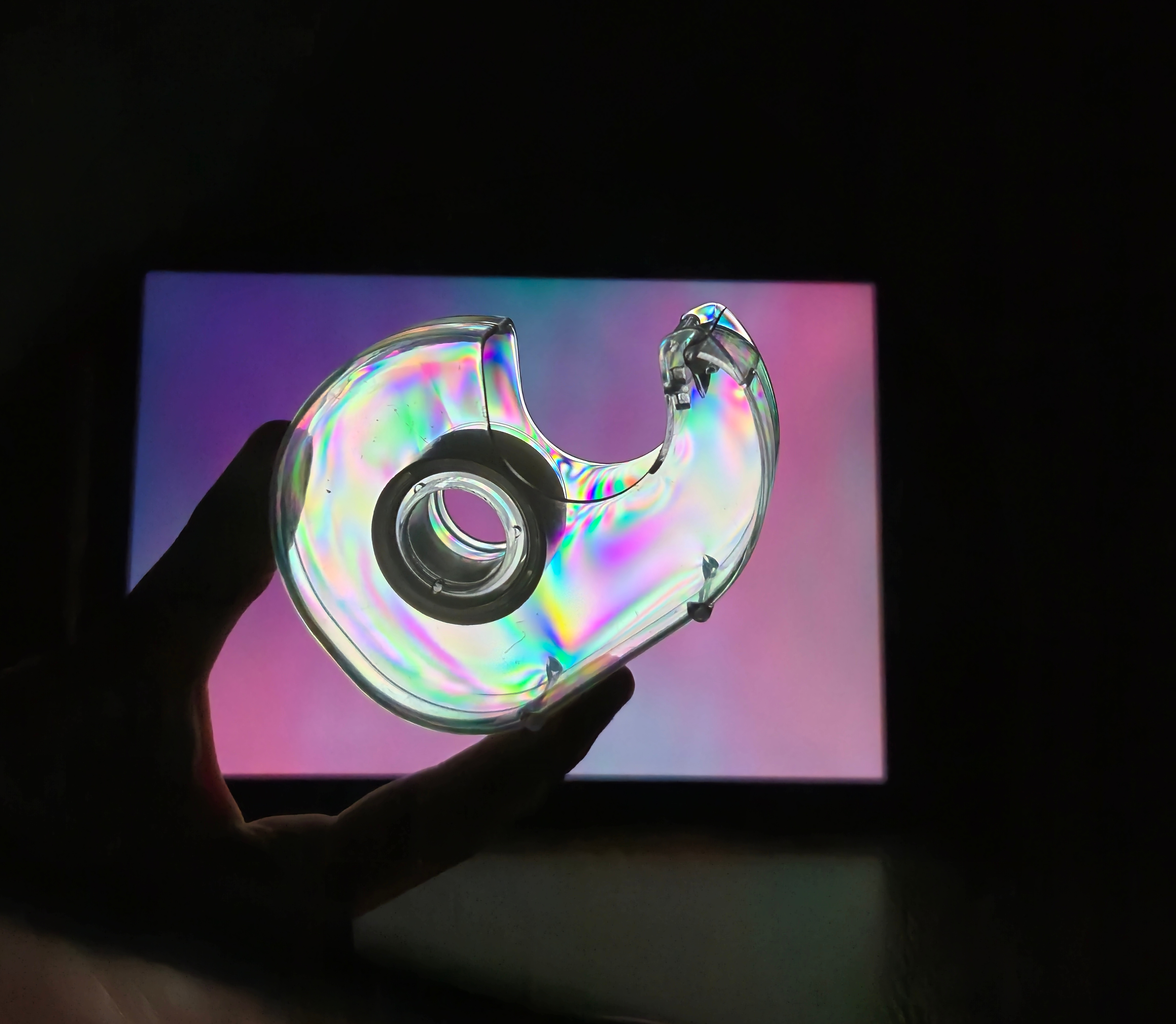
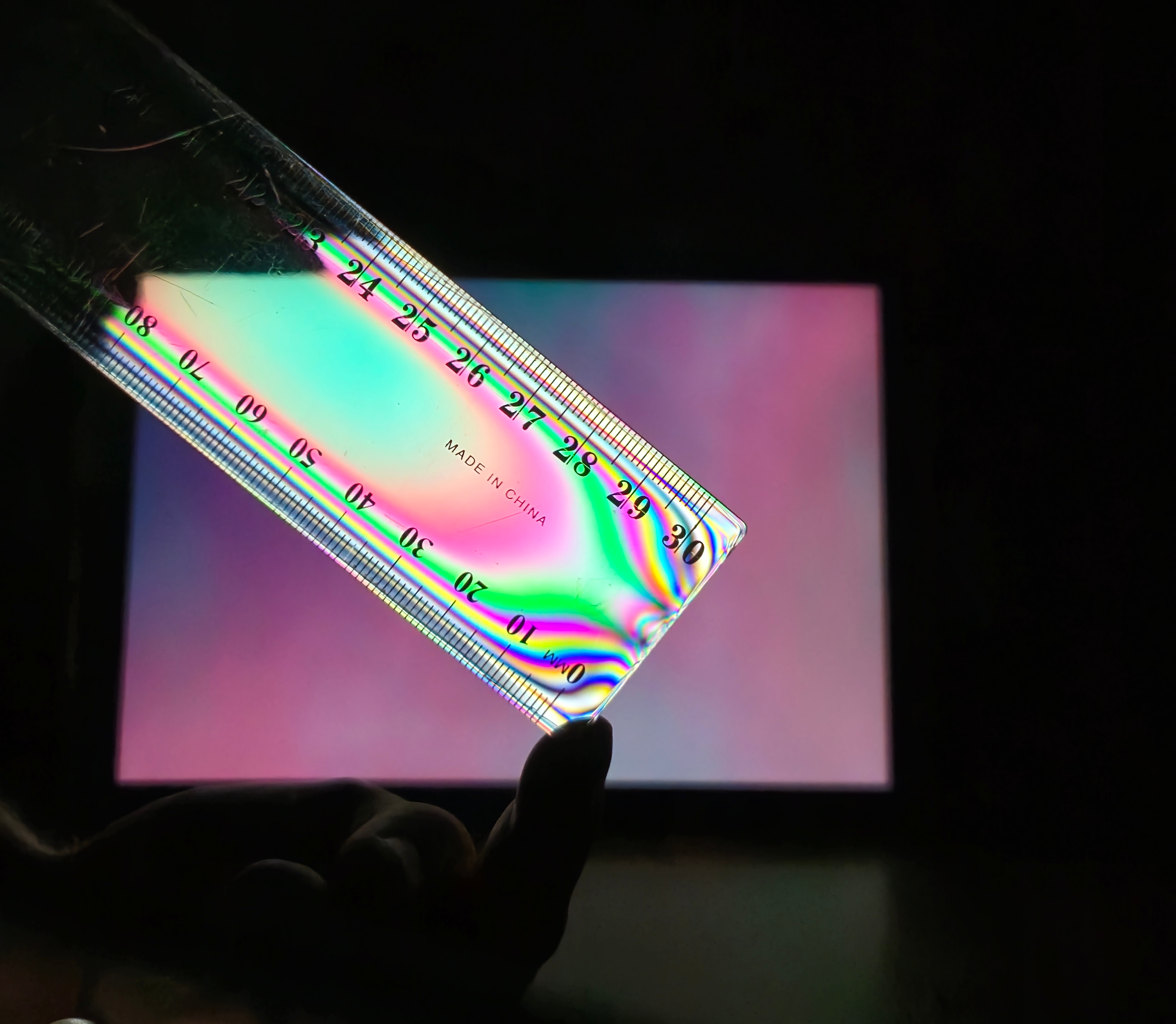
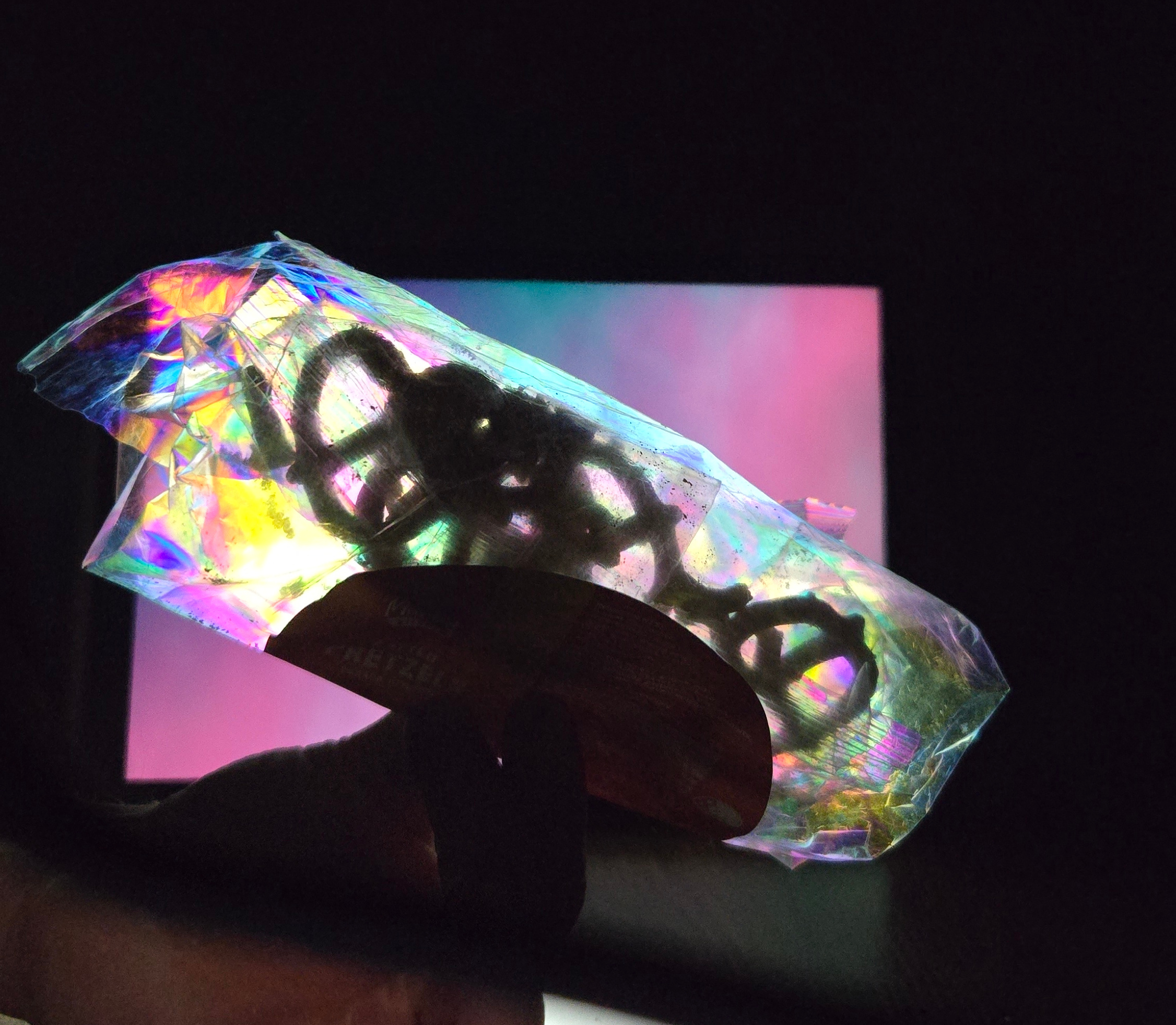
But the best thing I found was basic gelatin.
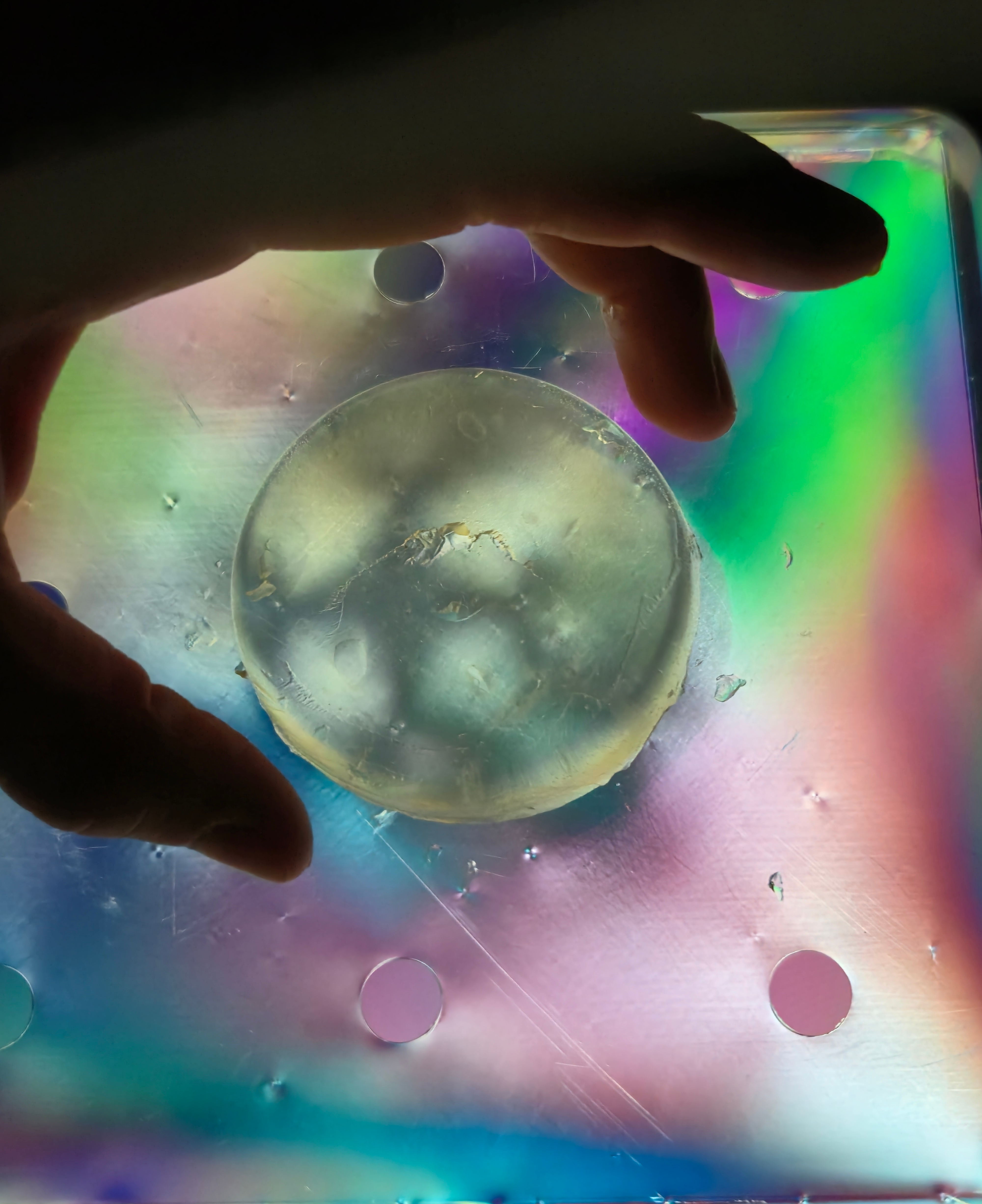
A good clean blob of gelatin between my filters is clear at first, and then passes one by one through all the colours of the rainbow when you apply stronger and stronger stress. Importantly, this means I can be systematic. I can start with a simple stress, something that really is just cleanly one force (my squeezing) acting on one part of the shape (its diameter right between my fingers).
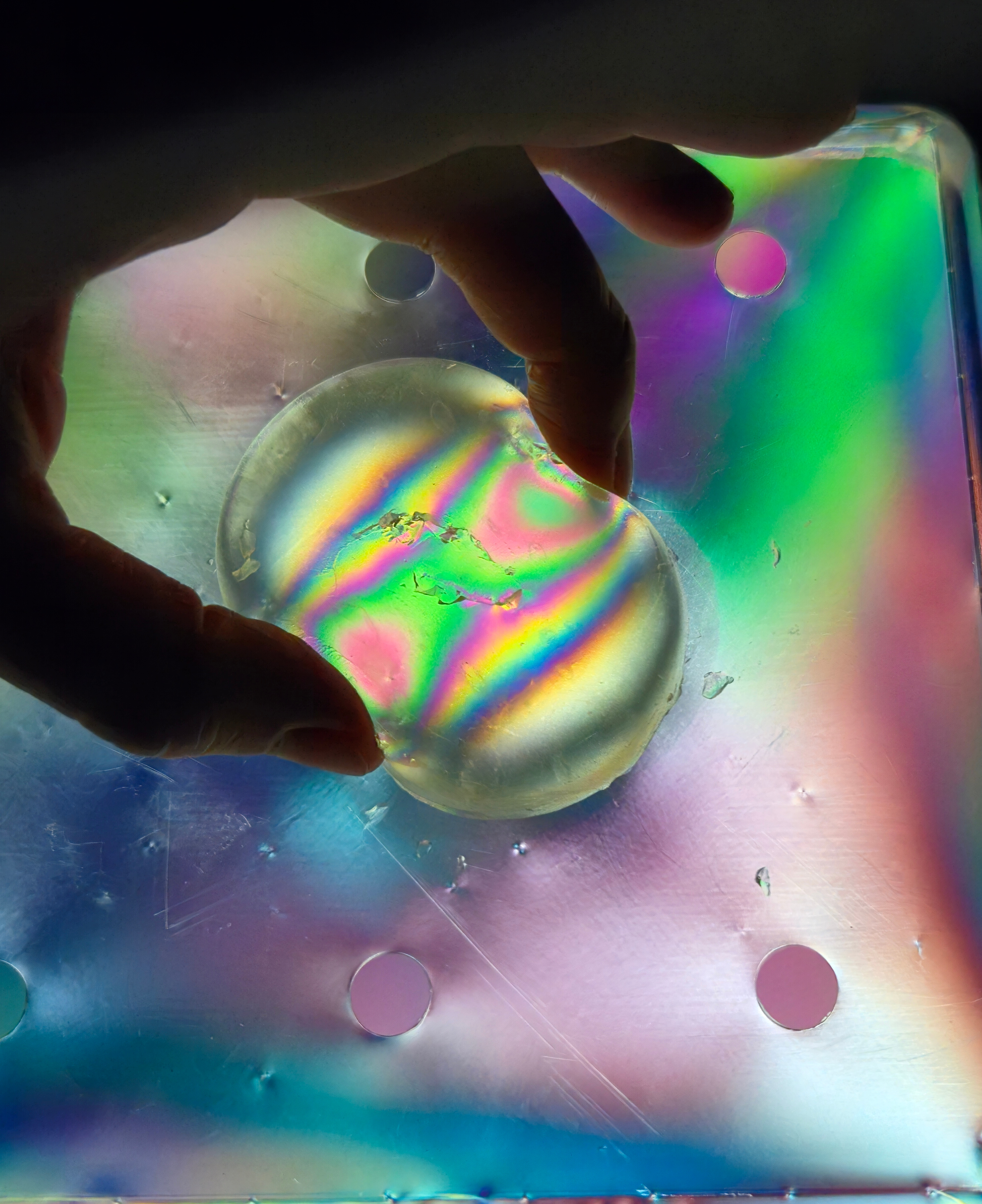
I can squeeze any direction I like and it’ll behave about the same and I can understand the stress I’m applying in exactly the same way. But If I use both hands and squeeze along two axes at the same time, now what happens?
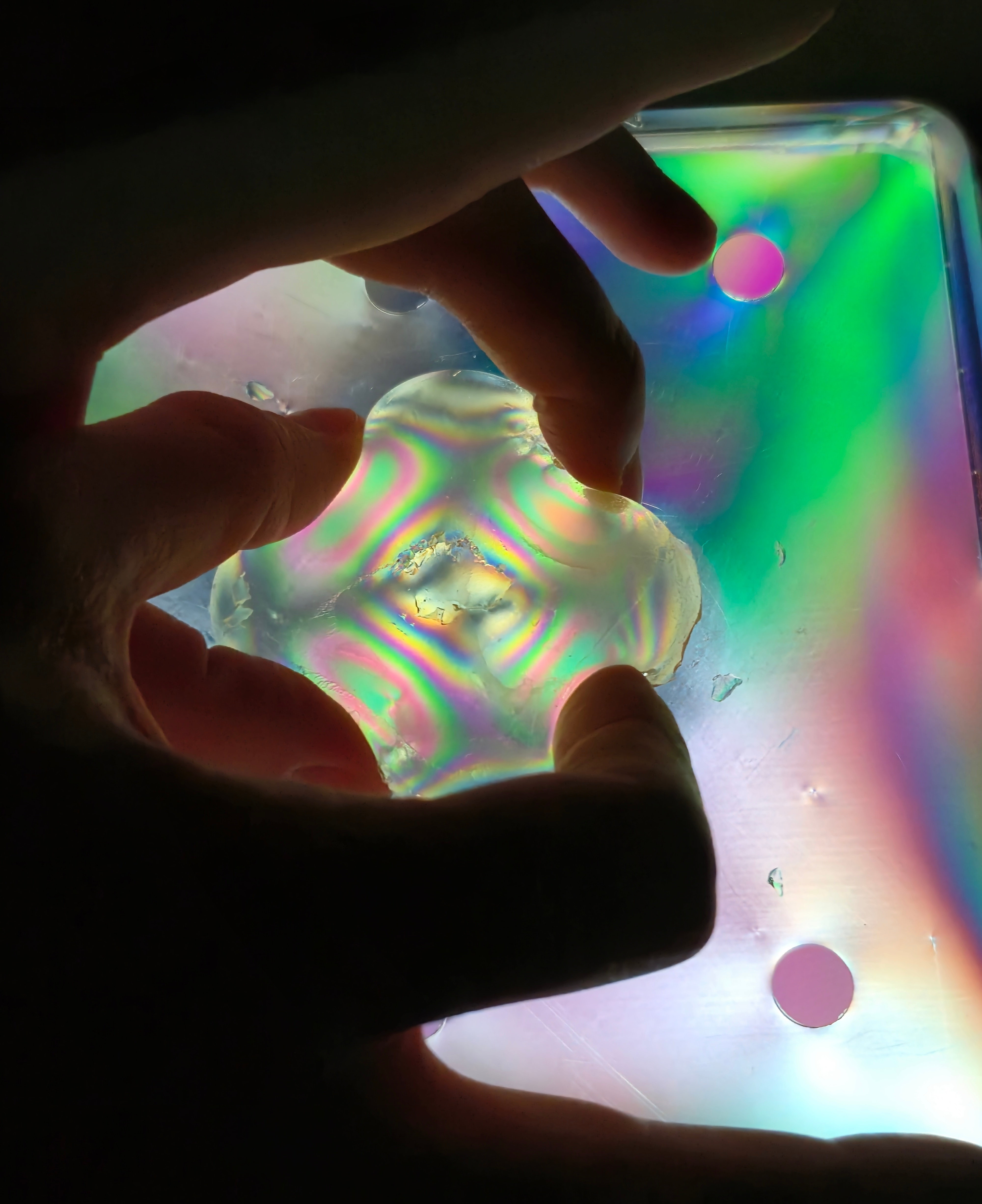
There is one stress everywhere in the film, including right in the middle. You can see it all; the light passing through the gelatin sees the stress in the material and changes colour accordingly. But what single force is pushing or tugging on what part of the shape? There isn’t one, it’s just… stressed. And that’s okay. The simple examples give us an intuition for what’s going on in the complicated examples, even if we no longer completely get them.
And believe it or not, quantum particles do the same thing.
Quantum Entanglement
Two quantum particles combine like force and geometry do when they make stress. They are not always two “quantumparticles” any more than stress is always one force on one part of a shape. Instead, two quantum particles are just “twoquantumparticles.”
Sometimes a pair of quantum things looks like a pair of quantum things and life is simple—this is the simple stress in my gelatin blob, a single force and a single part of the shape.
But sometimes a pair of quantum things is just its own thing, like the stress in the middle of my gelatin blob when I pinch it from two sides. We call that situation an “entangled” state because some kids have a hard time letting go of the individual particles and find it easier to picture it as if the two particles still exist but are twisted up together in a knot that just can’t be untied. But that’s just a crutch, Nature only sees the one situation like it saw the one stress in my gelatin, just one state of the “twoquantumparticles.” It’s just its own thing and we have to live with it.
Lottery World
So let’s go back to the lotteries from last time. Now I’m getting greedy, I’m going to enter two different lotteries at the same time.
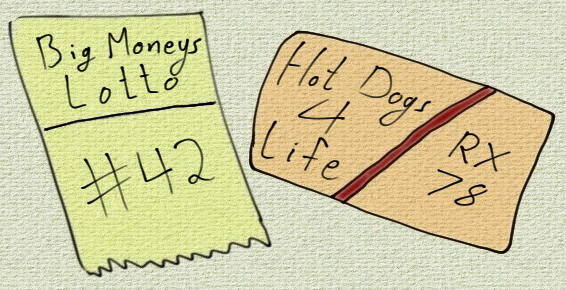
With independent non-mutually-exclusive events, probabilities can get a little clunky, so we're just going to focus on the greediest scenario, the odds of winning both lotteries.
Now my buddy got greedy too and bought his own set of tickets, but he chickened out and sold his pair of tickets to me at a sweet discount. In the regular world of regular probabilities, I just add each of his tickets to my set and now my probability of winning each lottery has just doubled so my odds of winning both has quadrupled! Nice.
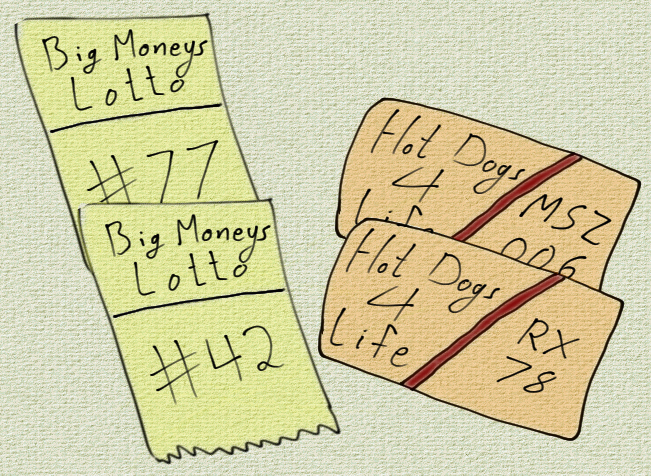
But things look very different with a quantum lottery. Quantum lottery tickets tensor together, so individually, my friend and I each have one “pairoftickets,” like this:
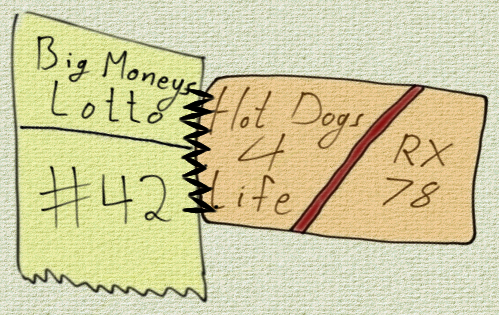
A “pairoftickets” is just a single ticket for a bigger quantum lottery, so two of them add together the exact same way two quantum tickets added together for a single lottery last time, and the outcome is the same as before. That is, when I buy my friend’s “pairoftickets,” my odds of winning only range from 0 to 2 times my original odds—a far cry from quadrupling them!

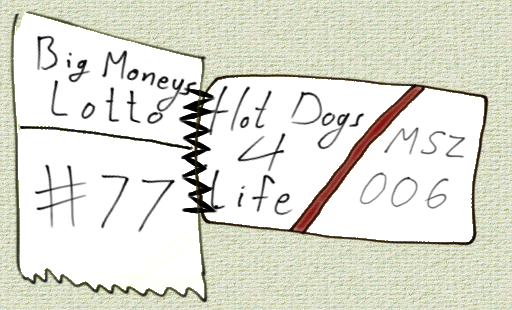
In the context of a lottery, this would be a bit of a rip-off, but in the context of encoding information and algorithms it’s a real treat. Mathematically the difference between these two scenarios is an exploitable difference of precision and control.
So Reason #3
When you group together individual quantum things, you get a whole new and bigger quantum thing that acts like its own wave. This can be daunting conceptually, but mathematically and practically it’s a boon, it means entire configurations of the system can be manipulated and made to interfere with each other, precisely singling out the desired algorithmic outcome.
Addendum: It didn’t have to be this way
It really is not trivial that quantum things tensor together. Life could have been much simpler, there are cleaner mathematical ways to stitch physical concepts together. The best and most common is called the direct sum5 ($\oplus$):
\[\text{Total} = \text{Thing 1} \oplus \text{Thing 2}\]and it works just like my non-quantum tickets above, there’s always a clear picture of thing 1 (my tickets for the first lottery) and thing 2 (my tickets for the second) and I can play around with each of them and they’ll never complain.
In fact, I’ll let you in on a little secret. There’s one special place in the quantum world where particles do add together in this simple way. When different states of angular momentum add together, they tensor up like anything else, but with a little change in perspective it turns out they look exactly like a bunch of different angular momenta that are stuck together with this lovely uncomplicated product. It’s an incredibly powerful and underappreciated technique in theoretical physics and it will get a whole article to itself soon (I’ll edit this with the link when it’s up).
Pre-emptive Complaints
You were taught poorly.
Sure thing. For my classical system, I've got two independent events so their joint probability is $P(A \cap B) = P(A)P(B)$ so when I double both probabilities I quadruple my total odds. Notice that this lines up with what you'd get if the ticket states were tied together with the direct sum, because then you'd have $(A1)\oplus(B1) + (A2)\oplus(B2) = (A1+A2)\oplus(B1 + B2)$.
For my quantum system, I simply have $\ket{T1} = \ket{A1}\ket{B1}$ and $\ket{T2} = \ket{A2}\ket{B2}$ so the combined system is $\ket{T} = \ket{A1}\ket{B1} + \ket{A2}\ket{B2}$ up to relative phase and normalization. The key is this misses the two cross terms you would get with the direct sum ($\ket{A1}\ket{B2}$ and $\ket{A2}\ket{B1}$), so you're missing half the states and so half the total probability amplitude.
Footnotes
-
In fact, this is where the name “tensor” came from, from the Latin tendere, to stretch. ↩
-
Like the 100% not-a-scam timeshare seminar in the next room and the MLM seminar the next day. ↩
-
Lucky critters… ↩
-
I needed a wider light source for this, so instead of the first pair of sunglasses I’m using a tablet screen which emits pre-polarized light. ↩
-
Or the Cartesian product $\times$, different only for infinite dimensions (ask your friendly neighbourhood mathematician, they love that kind of thing). ↩
Enjoyed This Article?
Here are some more you might like: